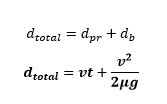Accounting for Perception-Reaction Time: The Stopping Distance Equation
On the last page, we saw that the smallest achievable braking distance is given by the following math equation:

But... this only accounts for what happens after the brakes are applied. We also have to consider a factor called perception-reaction time, which is time required for the train engineer to recognize the need to stop, and to trigger the brakes. On average, perception-reaction time has been determined to be approximately 1 second. This means that if you were the train engineer, you would see the car stuck on the tracks ahead and react to it in approximately 1 second. How far would your train travel in that amount of time, during which you were moving toward the brakes? Here is the equation for the distance traveled during perception-reaction time:

When we put these last two equations together, we get a basic equation for the total stopping distance required to stop the train once you've seen the car stuck on the tracks:

